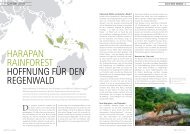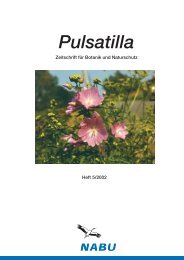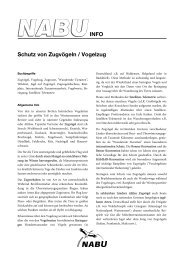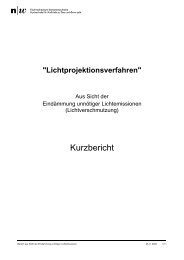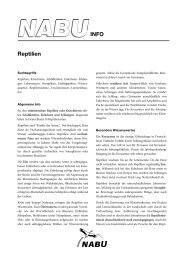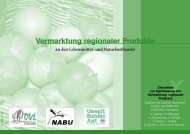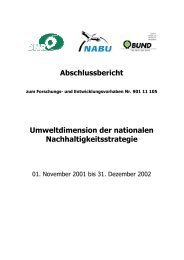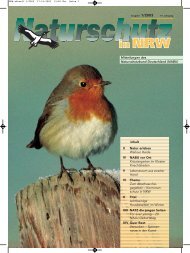Studie "The GMO-emperor has no clothes" (engl.) - Nabu
Studie "The GMO-emperor has no clothes" (engl.) - Nabu
Studie "The GMO-emperor has no clothes" (engl.) - Nabu
You also want an ePaper? Increase the reach of your titles
YUMPU automatically turns print PDFs into web optimized ePapers that Google loves.
VI. <strong>The</strong> History of Monsanto<br />
A. Timeline: 1901-2009*<br />
Over its 108-year history, Monsanto Co (MON.N), the world’s largest seed company, <strong>has</strong> evolved<br />
from primarily an industrial chemical concern into a pure agricultural products company. Following is a<br />
timeline of the St. Louis, Missouri-based company’s history published by Reuters, 11 November 2009.<br />
! 1901 - Original Monsanto founded as a maker<br />
of saccharine by John F. Queeny and named after<br />
his wife, Olga Monsanto Queeny.<br />
! 1920s and 1930s - Manufacturers sulfuric acid<br />
and other chemicals, including polychlorinated<br />
biphenyls (PCBs), which are later implicated in<br />
reproductive, developmental and immune system<br />
disorders.<br />
! 1940s - Manufactures plastics and synthetic<br />
fabrics<br />
! 1960s - Establishes agricultural division with<br />
focus on herbicides.<br />
! 1962-1971 - Becomes one of principal<br />
companies supplying herbicide k<strong>no</strong>wn as Agent<br />
Orange to U.S. military for use in Vietnam War.<br />
Agent Orange is later linked to various health<br />
problems, including cancer.<br />
! 1976 - Commercializes Roundup herbicide,<br />
which goes on to be a top seller around the world.<br />
! 1982 - Some 2,000 people are relocated from<br />
Times Beach, Missouri, after area is contaminated<br />
with PCB by-product dioxin. Critics say a St.<br />
Louis-area Monsanto chemical plant was a source<br />
but company denies any connection.<br />
! 1994 - Wins regulatory approval for its first<br />
biotech product, a dairy cow hormone called<br />
Posilac.<br />
! 1996 - Introduces first biotech crop, Roundup<br />
Ready soybeans, which tolerate spraying<br />
of Roundup herbicide, and biotech cotton<br />
engineered to resist insect damage.<br />
!"1997 - Spins off its industrial chemical and<br />
fibers business into Solutia Inc amid complaints<br />
and legal claims about pollution from its plants.<br />
Introduces new biotech ca<strong>no</strong>la, cotton and corn,<br />
and buys foundation seed companies.<br />
! 1998 - Introduces Roundup Ready corn.<br />
! 2000-2002 - Restructures in deal with<br />
Pharmacia & Upjohn Inc; separates agricultural<br />
and chemicals businesses and becomes standalone<br />
agricultural company.<br />
! 2002-2003 - Jury finds Monsanto plant in<br />
Anniston, Alabama, polluted community with<br />
PCBs. Monsanto and Solutia agree to pay $600<br />
million to settle claims brought by 20,000<br />
Anniston residents of PCB ground and water<br />
contamination.<br />
! 2003 - Solutia files Chapter 11 bankruptcy.<br />
! 2004 - Monsanto forms American Seeds Inc<br />
holding company for corn and soybean seed deals<br />
and begins brand acquisitions.<br />
! 2005 - Environmental, consumer groups<br />
question safety of Roundup Ready crops, say they<br />
create “super weeds,” among other problems.<br />
! 2006-2007 - Buys several regional seed<br />
companies and cotton seed leader Delta and Pine<br />
Land Co. Competitors allege Monsanto gaining<br />
seed industry mo<strong>no</strong>poly.<br />
! 2008 - Acquires sugarcane breeding companies,<br />
and a Dutch hybrid seed company. Sells Posilac<br />
business amid consumer and food industry<br />
concerns about the dairy cow hormone<br />
supplement.<br />
! 2008-2009 - U.S. Department of Justice says<br />
it is looking into mo<strong>no</strong>polistic power in the U.S.<br />
seed industry.<br />
! 2009 - Posts record net sales of $11.7 billion<br />
and net income of $2.1 billion for fiscal 2009.<br />
An<strong>no</strong>unces project to improve the living<br />
conditions of 10,000 small cotton and corn<br />
farmers in 1,100 villages in India; donates cotton<br />
tech<strong>no</strong>logy to academic researchers.<br />
*http://www.reuters.com/article/2009/11/11/foodmonsanto-idUSN1032100920091111<br />
49



